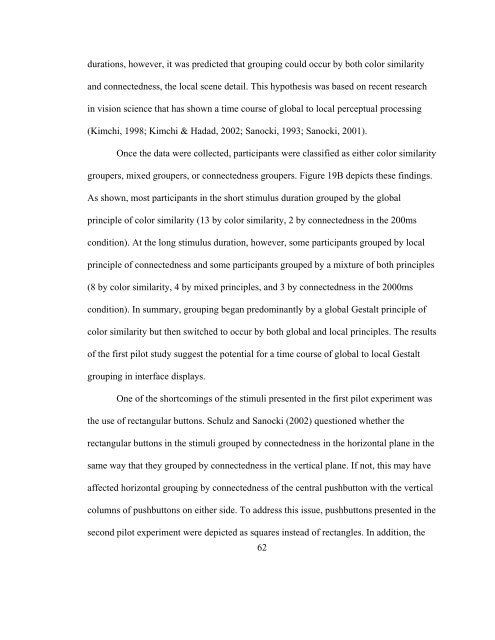The Use of Iambic Pentameter in the
The Use of Iambic Pentameter in the
The Use of Iambic Pentameter in the
Create successful ePaper yourself
Turn your PDF publications into a flip-book with our unique Google optimized e-Paper software.
durations, however, it was predicted that group<strong>in</strong>g could occur by both color similarity<br />
and connectedness, <strong>the</strong> local scene detail. This hypo<strong>the</strong>sis was based on recent research<br />
<strong>in</strong> vision science that has shown a time course <strong>of</strong> global to local perceptual process<strong>in</strong>g<br />
(Kimchi, 1998; Kimchi & Hadad, 2002; Sanocki, 1993; Sanocki, 2001).<br />
Once <strong>the</strong> data were collected, participants were classified as ei<strong>the</strong>r color similarity<br />
groupers, mixed groupers, or connectedness groupers. Figure 19B depicts <strong>the</strong>se f<strong>in</strong>d<strong>in</strong>gs.<br />
As shown, most participants <strong>in</strong> <strong>the</strong> short stimulus duration grouped by <strong>the</strong> global<br />
pr<strong>in</strong>ciple <strong>of</strong> color similarity (13 by color similarity, 2 by connectedness <strong>in</strong> <strong>the</strong> 200ms<br />
condition). At <strong>the</strong> long stimulus duration, however, some participants grouped by local<br />
pr<strong>in</strong>ciple <strong>of</strong> connectedness and some participants grouped by a mixture <strong>of</strong> both pr<strong>in</strong>ciples<br />
(8 by color similarity, 4 by mixed pr<strong>in</strong>ciples, and 3 by connectedness <strong>in</strong> <strong>the</strong> 2000ms<br />
condition). In summary, group<strong>in</strong>g began predom<strong>in</strong>antly by a global Gestalt pr<strong>in</strong>ciple <strong>of</strong><br />
color similarity but <strong>the</strong>n switched to occur by both global and local pr<strong>in</strong>ciples. <strong>The</strong> results<br />
<strong>of</strong> <strong>the</strong> first pilot study suggest <strong>the</strong> potential for a time course <strong>of</strong> global to local Gestalt<br />
group<strong>in</strong>g <strong>in</strong> <strong>in</strong>terface displays.<br />
One <strong>of</strong> <strong>the</strong> shortcom<strong>in</strong>gs <strong>of</strong> <strong>the</strong> stimuli presented <strong>in</strong> <strong>the</strong> first pilot experiment was<br />
<strong>the</strong> use <strong>of</strong> rectangular buttons. Schulz and Sanocki (2002) questioned whe<strong>the</strong>r <strong>the</strong><br />
rectangular buttons <strong>in</strong> <strong>the</strong> stimuli grouped by connectedness <strong>in</strong> <strong>the</strong> horizontal plane <strong>in</strong> <strong>the</strong><br />
same way that <strong>the</strong>y grouped by connectedness <strong>in</strong> <strong>the</strong> vertical plane. If not, this may have<br />
affected horizontal group<strong>in</strong>g by connectedness <strong>of</strong> <strong>the</strong> central pushbutton with <strong>the</strong> vertical<br />
columns <strong>of</strong> pushbuttons on ei<strong>the</strong>r side. To address this issue, pushbuttons presented <strong>in</strong> <strong>the</strong><br />
second pilot experiment were depicted as squares <strong>in</strong>stead <strong>of</strong> rectangles. In addition, <strong>the</strong><br />
62

















